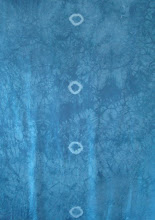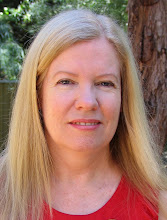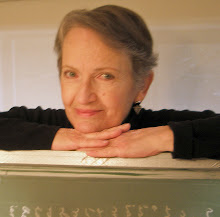
Many aha moments. I think I see what she is doing….it is fairly easy to slap a few layers of dye or stamping or screening on a light-value piece, but it is something else to start with a dark value (and already taking up most of the dye sites on this light-weight 12 mm silk) and bring it back to life. This smoky blue is exactly the same color I see when I look outside in December and January. It is a combination of the low, dark ceiling of wet clouds, the distant foggy and wet mountains, the wet driveway, my wet Gore-Tex jacket and hat after my wet walks. It is everything that makes me depressed in this bizarre climate. Using lively colors and imagery will help pull me above SAD.
I see that 402c Mixing Blue discharges to a good white whether it is a light value or dark value of the blue. This is great! Spent some time looking at the tools I already have and could use with this piece, and tools I might need to make. Have decided not to make any new silk-screens for this as there isn’t time. Think I want to use a couple of my older screens and then do the remainder with brushes and unthickened dye.
December 29: At the same time I am working on this challenge, I am learning how to use my new digital camera. I am on p. 13 of 123 pages, and so far the only thing I have learned is that I shouldn’t carry my digital camera in my back pocket because it could blow up if I sat on it.
December 30: Dye not yet arrived. Spent the afternoon sketching some design ideas. I know I want to discharge most of the blue. The tied resist circles, all on the same plane and all close in size. I wonder how I could design this piece so that the circles appear to be different sizes from each other and more scattered. Is this fiddling too much with Jane’s initial design? Is this permitted? Is this ethical? Having been raised in the 40’s and 50’s, I was taught to wait and ask for permission. How many opportunities have I missed doing this? Took me many years to unteach myself. Well, in her guidelines Jane gave us a lot of leeway so I shall forge on.

December 31: Dye arrived this morning. Dyed some of my own 12 mm with the dye to use as test pieces and for auditioning dye colors and paint colors.

January 1: Coated the test piece with flour paste. The formula I used became very thick after five minutes. Was difficult to spread on the silk. Just before the flour was dry, I impressed on one half with a Wel-Cote texture roller in what they call their “Swirl” design, which is more like overlapping shells, and then also circles with an oval whisk. Let it dry overnight.
January 2: Painted on Dye-Na-Flow in #812 Periwinkle and #822 Sulphur. Lesson learned: use a much lighter touch with the tools. I am also experimenting with gel medium as a permanent resist, and continuing with the flour paste.

January 9, 10, 11: LAYER 1 - Screened the matte gel onto the challenge piece. LAYER 2 - After the matte gel completely dried, I discharged the entire piece. There was a change to a much darker blue under the matte resist, which was a shock. It will make a difference in how I use my dye colors. Must change my color plans. I really liked the lighter blue under the discharge better.

January 13: LAYER 3 - Painted on flour paste. Found that I had to do this in stages, letting one area dry before going to another area. Let dry overnight.
January 14: Painted Dye-Na-Flow Sulphur and Periwinkle on LAYER 3.

While this was drying, I dye-painted my third test piece with new colors, dried it, steamed and stabilized it. It is so freeing to just paint dye stock solution on cloth rather than having to mix it with sodium alginate. I like the feeling of moving my arm and brush across the silk, observing how hues layer on top of each other. It becomes a meditation. The colors on this last test piece are gorgeous and just how I envisioned them. Even the depth of shade is perfect. Am I ever thankful I did all that testing beforehand.
January 15 – 17: I added dye layers, steaming in between. With this set of primaries which is new to me, because of the blue 402c, I have found a whole new palette…mustard, olive greens, rusts. Beautiful.

In the back of my mind, I have been imagining a secret room in a Bruges cloth merchant’s house circa 1400s where there is a stack of velvet sent from Italy for dyeing. When the historian discovers the room in 2007, the rich olive greens and purples have faded over time into mustards and lavenders. I am working on achieving the look of folded cloth piled in a corner. So far, the imagery is confusing, or, to use a Yiddish word, it looks too ongepotchket (to rhyme with Fonda Lodge kit) I am hoping to tame this when I add the textile paint layer.
I digress. Yiddish is such a colorful language. Ongepotchket means, “Slapped together without form or sense, messed up, or excessively and unaesthetically decorated, overly baroque.” (From The Joys of Yiddish) “Mr. Fleishman, a new art collector, bought a painting which was much admired by his friend Myerson, a self-proclaimed expert: The painting was one large square of black, with a dot of white in the center. A year later, Mr. Fleishman bought another painting by the same modernist genius: A large square with two white dots. Proudly, Fleishman hung the picture over his fireplace and telephoned his art maven friend Myerson to come right over. Myerson took one look at the picture and wrinkled his nose; “I don’t like it. Too ongepotchket.”
Thought I would interject some humor for my gentle reader in all of these “First I did this,” and “then I did that,” and “I didn’t like that so I did, blah, blah.”
February 4: My two weeks away on vacation have given me a fresh look at my challenge piece. My fresh look tells me that I am still uncomfortable with the composition, but that this color way has many possibilities. Applied the vat dye LAYER 9 this morning.

February 6: Added textile paint with a wall texture roller - the last layer - LAYER 11, in five colors: Lumiere Halo Violet-Gold, Setacolor Amethyst, Jacquard Metallic Violet, Setacolor Light Copper, and Lumiere Metallic Olive Green.
Conclusion: When I took my last digital photos of the finished cloth, and saw the completed piece as a whole through my camera, I was amazed that I had created another landscape, not the pile of ancient velvet cloths I imagined. I thought I’d exhausted my need to focus on landscapes, but I see I now have more landscapes waiting to be realized. I am reminded of Ralph Waldo Emerson’s quote, “The earth laughs in flowers.” My challenge piece looks like irrigation circles in fields of wildflowers.
Finished with one week to spare! I have had a sense of anxiety while working on this challenge; at the same time, however, each new layer brought such a sense of joy and discovery and new design challenges. I can say I am satisfied with this piece and eager to share it with the world.
















1 comment:
I appreciate this webpage, will definitely come back. Ensure you bring on composing top excellent content.
Post a Comment